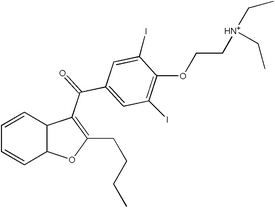Business Editors/Health/Medical Writers
HAWTHORNE, N.Y.--(BUSINESS WIRE)--Dec. 19, 2002
Taro Pharmaceutical Industries Ltd. (Nasdaq/NMS: TARO) reported today that the Company has received approval from the U.S. Food and Drug Administration ("FDA") for its Abbreviated New Drug Application ("ANDA") for Ketoconazole Cream, 2% ("Ketoconazole Cream").
Taro's Ketoconazole Cream is bioequivalent to Nizoral(R) Cream, a product of Janssen Pharmaceutica Products, L.P. Nizoral is a prescription pharmaceutical product used primarily for the treatment of fungal infections of the skin. According to industry sources, the annual U.S. market for Ketoconazole Cream is approximately $54 million.
"Ketoconazole Cream is an important addition to Taro's line of antifungal products and strengthens our leadership position in the U.S. topical prescription market," said Barrie Levitt, M.D., Chairman of the Company.
Amiodarone HCl Tablets, 100 mg and 400 mg ANDA Approved
The Company has also received FDA approval for its ANDA for Amiodarone Tablets, 100 mg and 400 mg. Amiodarone is used in treating atrial fibrillation and other cardiovascular conditions. While the 400 mg tablet is bioequivalent to Upsher-Smith's Pacerone(R) Tablets, Taro believes it is currently the only company with a 100 mg Amiodarone Tablet. In 2001, Taro received ANDA approval for 200 mg Amiodarone Tablets.
"By offering the choice among 100 mg, 200 mg and 400 mg Amiodarone Tablets, Taro hopes to enable physicians to simplify dosing regimens and more easily tailor treatment to the needs of individual patients," Dr. Levitt stated.
Taro currently has 16 ANDAs on file with the FDA, including one tentative approval. In addition, the Company has multiple regulatory filings in Canada, Israel and other countries around the world.
Taro is a multinational, science-based pharmaceutical company dedicated to meeting the needs of its customers through the discovery, development, manufacturing and marketing of the highest quality healthcare products.
For further information on Taro Pharmaceutical Industries Ltd., please visit the Company's website at www.taro.com.
Certain statements in this release are forward-looking statements within the meaning of the Private Securities Litigation Reform Act of 1995. Although Taro Pharmaceutical Industries Ltd. believes the expectations reflected in such forward-looking statements to be based on reasonable assumptions, it can give no assurance that its expectations will be attained. Factors that could cause actual results to differ include industry and market conditions, slower than anticipated penetration of new markets, marketplace acceptance of Taro's generic Ketoconazole Cream, 2% or Amiodarone Tablets, 100 mg, 200 mg and 400 mg, the future size of the market for these four products, changes in the Company's financial position, regulatory actions, and other risks detailed from time to time in the Company's SEC reports, including its 2001 Annual Report on Form 20-F.
COPYRIGHT 2002 Business Wire
COPYRIGHT 2002 Gale Group



